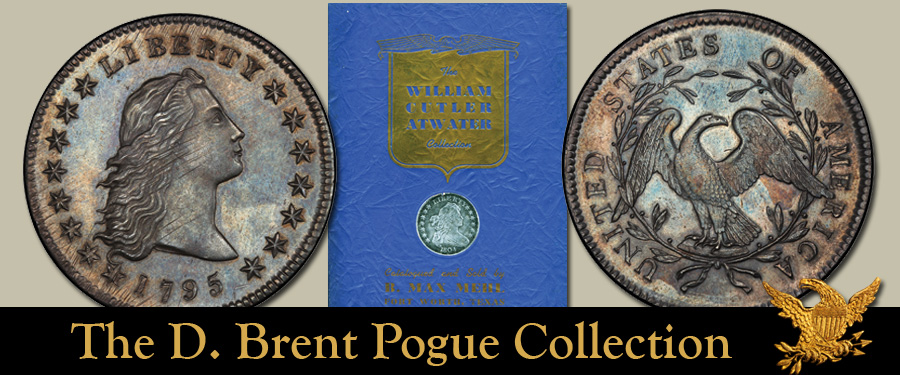
The William Cutler Atwater Coin
Tied for Finest Known
This week’s spotlight coin from the D. Brent Pogue Collection Part II comes from the small but impressive group of Flowing Hair dollars to be offered in this sale. Along with the gem 1794 and several other 1795 silver dollars this selection is unprecedented.
Pogue Part II will be held in the international headquarters of our partner, Sotheby’s, in New York City on September 30. On the next day, October 1, in the same venue we will have a companion Rarities Auction featuring important American coins. We invite you to attend, bring your friends and family, and be part of an event that forever echo in the halls of numismatics.
The memorable 1795 dollar featured this week was once part of the famous William Cutler Atwater Collection. “It is the most magnificent 1795 dollar of this type that I have ever seen,” commented B. Max Mehl in his 1946 offering of this coin.
It is somewhat prooflike and is deeply patinated on both sides in silver and deep brown highlighted by blue iridescence. The planchet for this dollar was found to be overweight prior to the striking of the coin, and the result of corrective measures can be seen in a series of fine obverse adjustment marks through the portrait, letters of LIBERTY and the first few stars. The portrait is well defined with nice execution of the hair waves and curls.
There is not another specimen of this variety known in Mint State, nor are there any in lower grades that approach this coin’s incredible visual appeal. As noted, nearly a half-century into his career, B. Max Mehl had never encountered a finer 1795 dollar. While Atwater’s source for this dollar is unknown, Mehl commented, “He was a consistent buyer of gem specimens.” Atwater acquired coins from many of the most notable auctions of the first quarter of the 20th century, as well as privately from dealers, including cherrypicking many choice specimens from the Col. James W. Ellsworth Collection while they were in the inventory of Wayte Raymond in 1923.
Among the spectacular Flowing Hair dollars of the D. Brent Pogue Collection, this one stands out for its rarity as a die variety. Described in the Haseltine Type-Table, written by J. Colvin Randall and published in 1881, this variety was listed as unique.
In 1950 when Milferd H. Bolender wrote the first stand-alone work on early dollars, he noted “the author’s example is probably the Haseltine specimen. Two others are known to the authors, and no others have been heard of in 40 years.” While more have been identified in the intervening decades, nearly all have been in well circulated grades. The only Mint State survivors from this die marriage are this coin and the Baldenhofer-Ostheimer piece, graded MS-62 (PCGS). Just two 1795 dollars of all varieties have been graded finer than this one by PCGS, and both will be in our September sale. Of the three examples of the date certified as MS-65 by PCGS, two will be offered. Amazing!
Some Information on William Cutler Atwater
William Cutler Atwater was born in Brooklyn, New York, on July 4, 1861, the son of John Hoadley Atwater and his wife Jane. He studied at Adelphia Academy in Brooklyn, followed by Amherst College where he graduated with an AB degree in 1884, after which he secured a position as a salesman for a coal merchant in New York City. After about five years in this occupation he established his own coal business at Fall River, Massachusetts, a depot for the arrival of coal to serve Boston and other mid- and northern New England cities. On May 1, 1889, he married Ida Wilson of Easton, Pennsylvania. The union produced four children.
Success attended his efforts in the coal trade, and in 1899 he purchased the mine whose coal he sold. In 1902 there was an anthracite strike in America. To secure supplies, he went to Wales to make tests of the quality of different coal available there. “He then purchased and shipped 90,000 tons of Welsh anthracite, thereby saving Fall River and other New England towns from a coal famine,” according to the 1946 B. Max Mehl catalog offering his collection.
In 1909 he diversified and purchased timberland, eventually acquiring 250 square miles of forest. He also developed Westhampton Beach, Long Island, where he constructed a large estate, a beach club, country club, and an 18-hole golf course. He owned a fine “tropical estate” at St. Petersburg. Atwater traveled widely, and visited many parts of the world. Not only did he enjoy coins, he was also interested in gardening, motorboats and yachting.
His firm continued to prosper, eventually selling over 3 million tons of coal per year. He also operated ocean-going steamships, made oil burners, and constructed oil terminals. By the time of his death at St. Petersburg, Florida on February 22, 1940, he was chairman of several firms in the coal and oil business.





